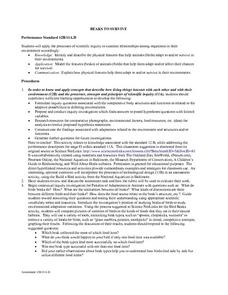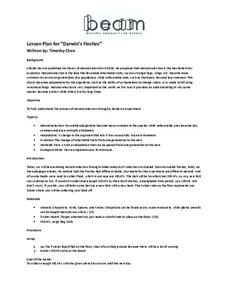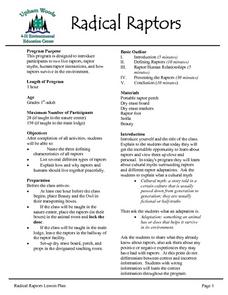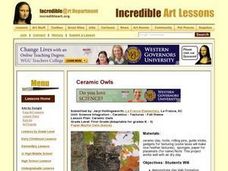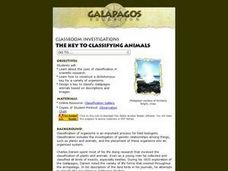Curated OER
What Is A Raptor?
Students examine the special characteristics of raptors and discover what separates them from other birds. Students look at different photographs from the Internet or magazines of several different birds and identify the raptors based on...
Curated OER
Beaks To Survive
High schoolers discuss and identify the types of adaptations that are made by different organisms in order for them to survive. In groups, they describe the features of beaks and discuss how it affects their chances for survival. They...
Berkeley Engineering and Mentors
Darwin's Finches
Try a twist on the old finch beak and chopsticks activity by using M&Ms on a Twister mat. Spoons, knives, forks, and chopsticks represent beaks and are randomly assigned to your little birds, who must collect as much food as possible...
Curated OER
Radical Raptors
Young scholars are introduced to raptors and their role in the environment. They identify three characteristics of raptors and list several types of raptors found in nature. They discuss their positive and negative experiences with...
Curated OER
Taxonomy
Students analyze the complexity of organism classifications based on certain criteria. In this classifying organisms lesson students study taxonomy and gather information and leaves to do their own experiment on classification.
Curated OER
The Living Environment
Young scholars use a spoon, clothespin, scissors, and toothpicks to simulate how animals get food in their environment. For this environment lesson plan, students learn about the adaptations animals make in order to survive.
Curated OER
Listen and Draw
Young scholars use their visualizing and interpreting skills to produce original writings and drawings. First, they listen to an adaptation of William Clark's description of the sage grouse. They form mental images that they translate...
Curated OER
Ceramic Owls
Learners creat owls through the use of slabs of clay with pinched beak and tufts. They use a clay tool or nail to add shape to mak wings. Students use shells, and other items to create texture. After the creations have dried, learners...
Curated OER
Discovering Owls
Students are introduced to different types of owls and owl pellets. They list several adaptations that benefit the owls. Students identify the various species of owl that live in Wisconsin. Students discuss owl pellets and identify the...
Curated OER
Wh0-o-o-o's Out There?
Fifth graders describe the physical features of an owl and identify survival adaptations. They Investigate an owl's niche in an ecosystem. The students participate in an interactive puzzle on the internet that helps for motivation.
Curated OER
FLY HIGH!!!
Students create their own bird study in their own schoolyard using the scientific method (see Testing a Hypothesis in Join the Project). Students do research in the library, at a local college, or on the Internet to determine the...
Curated OER
The Great Pollinators
Students discover the reproductive parts of a plant. In this biology lesson, students identify and categorize several different plants they dissect in class. Students record their information using a data chart.
Curated OER
The Key To Classifying Animals
Explorers of the environment construct a dichotomous key for a variety of organisms and design a key to classify Galapagos animals based on descriptions and images. The lesson includes a link to an animal gallery and the worksheet for...
Curated OER
Dancing Flamingos
Students, through the media of dance and drama, discover how an animal's behavior helps them to survive in the environment. They practice performing or mimicking how a flamingo's acts and positions itself when being observed. The...



